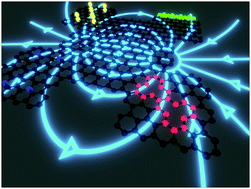当前位置:
X-MOL 学术
›
Chem. Soc. Rev.
›
论文详情
Our official English website, www.x-mol.net, welcomes your
feedback! (Note: you will need to create a separate account there.)
Emerging chemical strategies for imprinting magnetism in graphene and related 2D materials for spintronic and biomedical applications
Chemical Society Reviews ( IF 40.4 ) Pub Date : 2018-03-26 00:00:00 , DOI: 10.1039/c7cs00288b Jiří Tuček 1, 2, 3, 4, 5 , Piotr Błoński 1, 2, 3, 4, 5 , Juri Ugolotti 1, 2, 3, 4, 5 , Akshaya Kumar Swain 1, 2, 3, 4, 5 , Toshiaki Enoki 6, 7, 8 , Radek Zbořil 1, 2, 3, 4, 5
Chemical Society Reviews ( IF 40.4 ) Pub Date : 2018-03-26 00:00:00 , DOI: 10.1039/c7cs00288b Jiří Tuček 1, 2, 3, 4, 5 , Piotr Błoński 1, 2, 3, 4, 5 , Juri Ugolotti 1, 2, 3, 4, 5 , Akshaya Kumar Swain 1, 2, 3, 4, 5 , Toshiaki Enoki 6, 7, 8 , Radek Zbořil 1, 2, 3, 4, 5
Affiliation

|
Graphene, a single two-dimensional sheet of carbon atoms with an arrangement mimicking the honeycomb hexagonal architecture, has captured immense interest of the scientific community since its isolation in 2004. Besides its extraordinarily high electrical conductivity and surface area, graphene shows a long spin lifetime and limited hyperfine interactions, which favors its potential exploitation in spintronic and biomedical applications, provided it can be made magnetic. However, pristine graphene is diamagnetic in nature due to solely sp2 hybridization. Thus, various attempts have been proposed to imprint magnetic features into graphene. The present review focuses on a systematic classification and physicochemical description of approaches leading to equip graphene with magnetic properties. These include introduction of point and line defects into graphene lattices, spatial confinement and edge engineering, doping of graphene lattice with foreign atoms, and sp3 functionalization. Each magnetism-imprinting strategy is discussed in detail including identification of roles of various internal and external parameters in the induced magnetic regimes, with assessment of their robustness. Moreover, emergence of magnetism in graphene analogues and related 2D materials such as transition metal dichalcogenides, metal halides, metal dinitrides, MXenes, hexagonal boron nitride, and other organic compounds is also reviewed. Since the magnetic features of graphene can be readily masked by the presence of magnetic residues from synthesis itself or sample handling, the issue of magnetic impurities and correct data interpretations is also addressed. Finally, current problems and challenges in magnetism of graphene and related 2D materials and future potential applications are also highlighted.
中文翻译:

用于自旋电子和生物医学应用的在石墨烯和相关2D材料中压印磁性的新兴化学策略
自2004年孤立以来,石墨烯是一个二维的碳原子薄片,其排列方式类似于蜂窝状的六角形结构,已引起了科学界的极大关注。除了极高的电导率和表面积外,石墨烯还具有很长的自旋寿命有限的超精细相互作用,如果可以将其制成磁性,则有利于在自旋电子学和生物医学应用中的潜在开发。然而,由于仅sp 2,原始石墨烯本质上是抗磁性的杂交。因此,已经提出了各种尝试来将磁性特征压印到石墨烯中。本综述着重于对导致石墨烯具有磁性的方法的系统分类和物理化学描述。其中包括将点和线缺陷引入石墨烯晶格,空间限制和边缘工程,用外来原子掺杂石墨烯晶格和sp 3功能化。详细讨论了每种磁烙印策略,包括确定各种内部和外部参数在感应磁态中的作用,并评估其鲁棒性。此外,还回顾了石墨烯类似物和相关2D材料(例如过渡金属二卤化金属,金属卤化物,金属二氮化物,MXenes,六方氮化硼和其他有机化合物)中磁性的出现。由于石墨烯的磁性特征很容易被合成本身或样品处理过程中残留的磁性残留物掩盖,因此也解决了磁性杂质和正确数据解释的问题。最后,还重点介绍了石墨烯和相关2D材料的磁性方面的当前问题和挑战以及未来的潜在应用。
更新日期:2018-03-26
中文翻译:

用于自旋电子和生物医学应用的在石墨烯和相关2D材料中压印磁性的新兴化学策略
自2004年孤立以来,石墨烯是一个二维的碳原子薄片,其排列方式类似于蜂窝状的六角形结构,已引起了科学界的极大关注。除了极高的电导率和表面积外,石墨烯还具有很长的自旋寿命有限的超精细相互作用,如果可以将其制成磁性,则有利于在自旋电子学和生物医学应用中的潜在开发。然而,由于仅sp 2,原始石墨烯本质上是抗磁性的杂交。因此,已经提出了各种尝试来将磁性特征压印到石墨烯中。本综述着重于对导致石墨烯具有磁性的方法的系统分类和物理化学描述。其中包括将点和线缺陷引入石墨烯晶格,空间限制和边缘工程,用外来原子掺杂石墨烯晶格和sp 3功能化。详细讨论了每种磁烙印策略,包括确定各种内部和外部参数在感应磁态中的作用,并评估其鲁棒性。此外,还回顾了石墨烯类似物和相关2D材料(例如过渡金属二卤化金属,金属卤化物,金属二氮化物,MXenes,六方氮化硼和其他有机化合物)中磁性的出现。由于石墨烯的磁性特征很容易被合成本身或样品处理过程中残留的磁性残留物掩盖,因此也解决了磁性杂质和正确数据解释的问题。最后,还重点介绍了石墨烯和相关2D材料的磁性方面的当前问题和挑战以及未来的潜在应用。











































 京公网安备 11010802027423号
京公网安备 11010802027423号